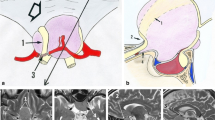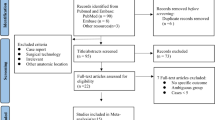Abstract
Background
Tuberculum sellae meningiomas are challenging to treat when accompanied with altered vision due to compression of the optic nerve. These tumors mostly refer to be benign; therefore, gross total removal and excellent functional recovery are desired.
Method
We describe the microsurgical treatment of tuberculum sellae meningioma with altered vision function on the left eye. Intradural unroofing of the optic canal with gross total resection of the tumor led to immediate excellent recovery. Intraoperative video highlights key steps of our surgical approach.
Conclusion
Optic canal unroofing is in our opinion safe and mandatory when treating tuberculum sellae meningiomas with compression of optic nerve.



Similar content being viewed by others
References
Chi JH, McDermott MW (2003) Tuberculum sellae meningiomas. Neurosurg Focus 14(6):E6 (1-6)
Mariniello G, de Divitiis O, Bonavolontà G, Maiuri F (2013) Surgical unroofing of the optic canal and visual outcome in basal meningiomas. Acta Neurochir 155:77–84
Mortazavi MM, Brito da Silva H, Ferreira M Jr, Barber JK, Pridgeon JS, Sekhar LN (2016) Planum sphenoidale and tuberculum sellae meningiomas: operative nuances of a modern surgical technique with outcome and proposal of a new classification system. World Neurosurg 86:270–286
Nozaki K, Kikuta KI, Takagi Y, Mineharu Y, Takahashi JA, Hashimoto N (2008) Effect of early optic canal unroofing on the outcome of visual functions in surgery for meningiomas of the tuberculum sellae and planum sphenoidale. Neurosurgery 62:839–846
Peto I, White TG, Dehdashti (2020) How I do it: contralateral approach for tuberculum sellae meningioma. Acta Neurochir 162:613–616
Rhoton AL (2002) The Sellar Region. Neurosurgery 51(Suppl 1):335–374
Spektor S, Dotan S, Mizrahi CJ (2013) Safety of drilling for clinoidectomy and optic canal unroofing in anterior skull base surgery. Acta Neurochir 155:1017–1024
Taha ANM, Erkmen K, Dunn IF, Pravdenkova S, Al-Mefty O (2011) Meningiomas involving the optic canal: pattern of involvement and implications for surgical technique. Neurosurg Focus 30(5):E12 (1-8)
Yasargil MG (1996) Meningiomas. In Yasargil MG Microneurosurgery IVB: Microneurosurgery of CNS Tumors Thieme New York, pp 134–165
Author information
Authors and Affiliations
Corresponding author
Ethics declarations
Ethical approval
All procedures performed in studies involving human participants were in accordance with the ethical standards of the institutional and/or national research committee and with the 1964 Helsinki Declaration and its later amendments or comparable ethical standards.
Informed consent was obtained from an individual participant included in the study.
Conflict of interest
The authors declare no competing interests.
Additional information
Publisher's note
Springer Nature remains neutral with regard to jurisdictional claims in published maps and institutional affiliations.
Key points
1. Correct position of head using gravity retraction, neuronavigation is not necessary.
2. Subfascial technique of preservation of facial nerve branches with retrograde disseaction of the temporal muscle to prevent muscle atrophy.
3. Dissection of proximal Sylvian fissure and opening of the arachnoid cisterns to achieve retractorless microsurgery.
4. Debulking of the tumor.
5. Early unroofing of the optic canal after initial debulking—before any dissection around ON is taken.
6. Removing of cottonoids before drilling to avoid entanglement to rotating drill.
6. Irrigation as long as repeated interruption of the drilling is mandatory in order to decrease the risk of thermal injury to the optic nerve.
7. Stop the drilling when there is still a thin plate of bone, which can be easily breakout with the disector.
8. Dissection of the falciform ligament and nerve sheet to deliberate the ON.
9. GTR of the tumor around the ON and surrounding structures.
10. Check for any suspicious communication with the sinus. When present, adequate closure is necessary.
This article is part of the Topical Collection on Tumor - Meningioma
Supplementary Information
Below is the link to the electronic supplementary material.
Supplementary file1 (MP4 142876 KB)
Rights and permissions
About this article
Cite this article
Kozák, J., Bízik, I., Novotný, M. et al. How I do it: optic canal unroofing in surgery for tuberculum sellae meningiomas with compression of the optic nerve. Acta Neurochir 164, 1397–1400 (2022). https://doi.org/10.1007/s00701-021-05083-9
Received:
Accepted:
Published:
Issue Date:
DOI: https://doi.org/10.1007/s00701-021-05083-9




